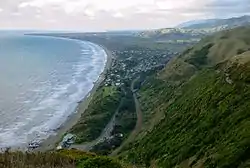| Elachista eurychora | |
|---|---|
.jpg.webp) | |
| Illustration of male | |
| Scientific classification | |
| Domain: | Eukaryota |
| Kingdom: | Animalia |
| Phylum: | Arthropoda |
| Class: | Insecta |
| Order: | Lepidoptera |
| Family: | Elachistidae |
| Genus: | Elachista |
| Species: | E. eurychora |
| Binomial name | |
| Elachista eurychora | |
| Synonyms[3][4] | |
| |
Elachista eurychora is a species of moth in the family Elachistidae. This species is endemic to New Zealand and has only been collected at Paekākāriki. The habitat where the adult moth was originally collected was in rough vegetation on coastal sandhills or dunes but the collection locality has been significantly modified since that time. It has been hypothesised that the host of the larvae of this species is a grass. Adults are on the wing in March. It is classified as "Data Deficient" by the Department of Conservation.
Taxonomy

This species was originally described by Edward Meyrick in 1919 and named Irenicoves eurychora.[3][5] Meyrick used a male specimen collected by George Hudson at in March.[5] Hudson discussed and illustrated this species under that name in his 1928 publication The Butterflies and Moths of New Zealand.[6] In 1971 Elwood Zimmerman photographed and illustrated this species and reassigned it to the family Elachistidae.[7] In 1999 Lauri Kaila revised the family Elachistidae and confirmed the placement of this species within the genus Elachista.[4] The holotype specimen is held at the Natural History Museum, London.[3]
Description
.jpg.webp)
Meyrick described the species as follows:
♂. 13 mm. Head and thorax pale-ochreous. Palpi whitish, second joint suffused with grey anteriorly except at apex. Antennae grey. Abdomen dark grey, anal tuft ochreous-whitish mixed with grey. Fore-wings narrowly elongate-lanceolate, long-pointed, acute; pale brownish-ochreous; a costal streak of dark-fuscous irroration from base to near apex, and a similar somewhat narrower dorsal streak attenuated to extremities from base to near tornus: cilia grey, towards base scaled with pale ochreous. Hindwings dark fuscous: cilia rather dark grey.[5]
Distribution

This is endemic in New Zealand.[2][8] This species has only been found in the Wellington region.[9] Hudson's specimen is the only time this species has been collected.[10]
Host and habitat
It has been hypothesised that the host of the larvae of this species is a grass.[9] The habitat where the adult moth was originally collected was in rough vegetation on coastal sandhills or dunes.[6] However this locality has been significantly modified since that time.[9]
Behaviour
Adults of this species are on the wing in March.[6]
Conservation status
This species has been classified as having the "Data Deficient" conservation status under the New Zealand Threat Classification System.[1]
References
- 1 2 Hoare, R.J.B.; Dugdale, J.S.; Edwards, E.D.; Gibbs, G.W.; Patrick, B.H.; Hitchmough, R.A.; Rolfe, J.R. (2017). "Conservation status of New Zealand butterflies and moths (Lepidoptera), 2015" (PDF). New Zealand Threat Classification Series. 20: 8.
- 1 2 "Elachista eurychora (Meyrick, 1919)". www.nzor.org.nz. Landcare Research New Zealand Ltd. Retrieved 2018-05-31.
- 1 2 3 Dugdale, J. S. (1988). "Lepidoptera - annotated catalogue, and keys to family-group taxa" (PDF). Fauna of New Zealand. 14: 1–269. ISBN 0477025188. Archived from the original (PDF) on 27 January 2019. Retrieved 3 February 2018.
- 1 2 Lauri Kaila (April 1999). "Phylogeny and classification of the Elachistidae s.s. (Lepidoptera: Gelechioidea)". Systematic Entomology. 24 (2): 139–169. doi:10.1046/J.1365-3113.1999.00069.X. ISSN 0307-6970. Wikidata Q54487862.
- 1 2 3 Meyrick, E. (1919). "Descriptions of New Zealand Lepidoptera". Transactions and Proceedings of the New Zealand Institute. 51: 349–354 – via Biodiversity Heritage Library.
- 1 2 3 Hudson, G. V. (1928). The Butterflies and Moths of New Zealand. Wellington: Ferguson & Osborn Ltd. p. 259. OCLC 25449322.
- ↑ Zimmerman, E. C. (1971). "The New Zealand moth genus Irenicodes (Lepidoptera: Cycnodiidae)". New Zealand Entomologist. 5 (1): 53–55. doi:10.1080/00779962.1971.9722957.
- ↑ Gordon, Dennis P., ed. (2010). New Zealand inventory of biodiversity: Kingdom animalia : chaetognatha, ecdysozoa, ichnofossils. Vol. 2. p. 458. ISBN 978-1-877257-93-3. OCLC 973607714. OL 25288394M. Wikidata Q45922947.
- 1 2 3 Patrick, B. H.; Dugdale, J. S. (2000). "Conservation status of the New Zealand Lepidoptera" (PDF). Science for Conservation. Department of Conservation, New Zealand. 136: 22. ISSN 1173-2946. Archived from the original (PDF) on 2017-05-01. Retrieved 2018-05-31.
- ↑ "NZTCS-Lepidoptera". www.doc.govt.nz. 2013. Retrieved 30 May 2018.
